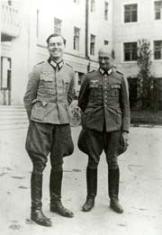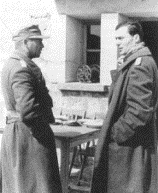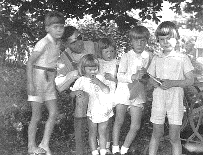![]()
Chapters
References
War and Realization (Continued)
|
Stauffenberg also used his position to create a Russian
Liberation Army after the Germans invaded that country
(Operation Barbarossa) in 1941. Many Russians, while no friend
of Hitler by any means, were certainly no friend of Josef Stalin
who was the communist dictator of the country. Ideally,
Stauffenberg wished to turn the invasion in his area into a war
of liberation by those Russians and non-Russians who detested
the Stalinist regime. He had no problems finding willing
recruits for the cause. By 1943 the Wehrmacht had successfully
recruited an unofficial estimate of between one hundred thirty
to one hundred fifty thousand former Red Army soldiers into
volunteer battalions. “The success of these measures was soon
to be seen. There was no guerilla warfare in the Caucuses, and
the North Caucasian people were soon fighting enthusiastically
on the German side.”[15] Hitler however, in one of his
many blunders as commander-in-chief of the German armed forces,
ordered the program stopped.
And as 1942 drew to a close and
1943 began, the results of his decision would soon be seen as
the tide of war began to turn against Germany. The year 1943 would be pivotal for both Germany and Stauffenberg. After the Blitzkrieg (lightning attack) conquests of Poland and Western Europe, the mighty Wehrmacht began to show the reach of its resources as the army became bogged down in the Russian terrain. Within sight of Moscow and possible victory, the powerful war machine ground to a halt and dug in. The scene became more reminiscent of a World War One battlefield then the progress of the “lightning attack” doctrine that had developed since. In 1942 Hitler decided to shift his priority away from Moscow and concentrate his available forces to a city along the Volga River named Stalingrad. This small city had no particular strategic value but by having the name “Stalin” became a propaganda target. Due to a simple name, Hitler ordered the German Sixth Army to conquer the city. What ensued has been called one of the most ferocious battles of the Twentieth Century and ended with the surrender of what was left of the Sixth Army in February of 1943. The army had ample opportunity to escape before being surrounded but Hitler insisted that they hold until the last man. Now serving in North Africa as a Lieutenant Colonel, Stauffenberg became so incensed by the OKW chiefs who refused to tell Hitler the truth about the tenuous situation in the east that he remarked to a fellow officer, “the point is not to tell him the truth but to kill him, and I am prepared to do that.”[16] Destiny, however, was not quite ready for Stauffenberg to attempt this. In April of 1943 while on a patrol in Tunisia, Stauffenberg’s car was strafed by an allied fighter plane. Alive, but critically wounded, he would lose his right arm and eye as well as the index and ring finger of his left hand. He was flown back to Germany to recuperate. During his convalescence, Stauffenberg finally came to the realization that he must do something to save Germany before it was too late. As he remarked to his wife, “you know I must do something now to save Germany. We General Staff officers must all accept our share of the responsibility.”[17] At this point there would be no turning back for Stauffenberg. The proverbial dye was now cast and he only had a single purpose, the salvation of his country. To accomplish this he had to take the ultimate chance of killing Hitler and being labeled a traitor because no one else seemed willing to take the risk. For only through this act of treason, Stauffenberg realized, would he be able to save the nation he loved.
Public History at the University of North
Carolina at Charlotte
|
 Stauffenberg (left) with fellow officer and future conspirator Lieutenant Colonel Albrecht Mertz von Quirnheim, Ukraine, 1942  Stauffenberg (right) with Brigadier General Baron von Broich during his short tenure in North Africa, winter 1943  Stauffenberg (second from left, with eye patch) with his children, recuperating at home from his injuries in North Africa, summer 1943 |
